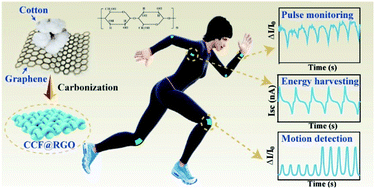Graphene decorated carbonized cellulose fabric for physiological signal monitoring and energy harvesting†
Abstract
The recent developments in wearable electronics urgently call for high-performance multi-functional fabrics for sensing and power supply. In this study, a carbonized cellulose fabric decorated by reduced graphene oxide (CCF@RGO) is fabricated into a robust and wearable multifunctional device, which demonstrates superior performance in pressure sensing and energy harvesting. The intertwined warp and weft structured cotton textiles with different structures can be converted into conductive carbon fabric while retaining their original fabric structure and natural flexibility. It is proved that graphene oxide (GO) has a promotive effect on the thermal decomposition of the cellulose fibers. Due to the buckling structure on the plain weave fabric surface, the prepared CCF@RGO based pressure sensor shows high sensitivity in a wide range. Furthermore, this conductive fabric can also be used in a single-electrode triboelectric nanogenerator (TENG) for harvesting biomechanical energy. Thus, this multifunctional CCF@RGO has potential applications in the fields of wearable electronics, artificial intelligence devices, human–machine interaction, and so forth.



 Please wait while we load your content...
Please wait while we load your content...